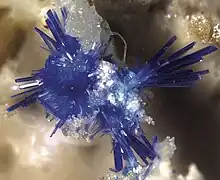Triazolite
Triazolite is an organic mineral with the chemical structure of NaCu2(N3C2H2)2(NH3)2Cl3·4H2O, and is formed in conjunction with chanabayite, another natural triazolate.[3] Triazolite has only been found in Pabellón de Pica, Chanabaya, Iquique Province, Tarapacá Region, Chile, due to its specific requirements for formation. The first specimens of triazolite were found in what is suspected to be the guano of the guanay cormorant.[4] The guano reacted to chalcopyrite-bearing gabbro, allowing the formation for triazolite to take place. Triazolite was initially grouped together with chanabayite in 2015, and wasn't identified as a separate mineral until 2017.
| Triazolite | |
|---|---|
 Closeup of a triazolite crystal[1] | |
| General | |
| Category | Mineral |
| Formula (repeating unit) | NaCu2(N3C2H2)2(NH3)2Cl3·4H2O |
| IMA symbol | Tzl[2] |
| Crystal system | Orthorhombic |
| Identification | |
| Color | Deep blue |
References
- Deep Carbon Observatory (2019). Deep Carbon Observatory: A Decade of Discovery. Washington, DC. doi:10.17863/CAM.44064. Retrieved 13 December 2019.
{{cite book}}: CS1 maint: location missing publisher (link) - Warr, L.N. (2021). "IMA–CNMNC approved mineral symbols". Mineralogical Magazine. 85 (3): 291–320. Bibcode:2021MinM...85..291W. doi:10.1180/mgm.2021.43. S2CID 235729616.
- "Triazolite". mindat.org. Retrieved 2017-12-09.
- "New carbon mineral #11 has strong family ties". Carbon Mineral Challenge. 18 October 2017. Retrieved 14 December 2019.
This article is issued from Wikipedia. The text is licensed under Creative Commons - Attribution - Sharealike. Additional terms may apply for the media files.